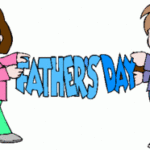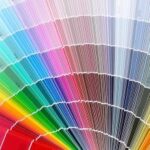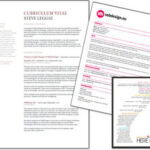When creating graphic design, it is important to work in layers. Imagine a layer is like a transparent piece of paper that you can lay on another piece of transparent paper. You can move each layer around on the page. You can also move it on top or underneath a different layer.
Here is an example of working only with one layer. Again, it’s best to imagine having one sheet of paper. Think of the hard work you put into drawing a beautiful portrait of your father. Now, you want to put a caption at the bottom of your portrait that says “Dad”. Working with the same layer, you insert this caption. Step back and take a look at the finished product. Hmmm… you think to yourself this would mean more if it said, “Father” instead of “Dad”. You’ve already put the word “Dad” at the bottom of the page on a portion of the portrait. Changing the name would require some erasing which would impact the original portrait. Knowing this will mess up the portrait, you either will need to start over or leave it as it is. Now, you will either spend more time re-creating the portrait or you will choose to leave it alone and not being completely satisfied with your final product.
See how working with just one layer can be difficult? Using multiple layers and the visualization I provided earlier with each item on separate transparent pages, now you can see how multiple layers will help. In this same situation, you would create the portrait on one layer and the word “Dad” on another layer. This way, if you don’t like the position of the word, you can move it above the portrait or you can delete it and start over without affecting the original portrait.
With Paint Shop Pro 7, this is how you will create multiple layers. First start by opening a new document. At the top, click on File then New. The Width and Height is up to you but let’s start with 500x 500 Pixels. To the right of the Width and Height is a drop down box where you can select “Pixels”. You can also choose inches and centimeters if you’d like.
Select the background color to be white. Later if you want to create your own background as a picture or different colors, you should change it to transparent.
Leave all other options as the current defaults. Click OK.
Make sure you have the following toolbars showing. Click View then click ToolBars. In the box that appears, put a checkmark next to Standard Toolbar, Photo Toolbar, Effects Toolbar, Tool Palette, Color Palette, Status Bar, Tool Options Palette & most importantly Layer Palette. When done, click Close.
The white that you see is considered the background. Now let’s insert text. We don’t want it to be part of the background so now we should create a new layer.
Step 1
Click on Layers at the top then click on NewRaster Layer. The defaults should be as follows. Name is self-explanatory. No need to really name the item. Blend mode should be Normal, Opacity should be 100%, Group should be 0, Layer is visible should be checked and both options under Mask should be checked. Click OK.
Step 2
Click on the black A, which appears on your toolbar. This is the option you select when you’re ready to insert text. Click on the white space. A Text Entry screen will come up. This is where you can choose your font and color of your text. For tutorial purposes, make the font name Arial and size 48. The styles have a stroke and fill. Fill is the color that the letters will be and stroke is if you want it lined with another color. For now, the stroke will be turned off showing a circle with a line through it. Fill should be the color black. Click once the color that you see then select black in the basic color section. You can make your font bold or italicize it if you’d like. In the text area, type Sophie (or your first name if you choose). Underneath that, Create as should be Floating and Antialias. Now click OK. Dotted lines will appear around the word you typed.
Step 3
Next repeat step 1 to create another layer. Repeat step 2 but this time making the text say Adams (or your last name if you prefer).
You will notice there is a moving dotted line around the word Adams that you created. This gives you options to create effects using only this word, which I will demonstrate in another tutorial.
Moving items in each layer
On your toolbar, click on the icon that has double arrows that cross each other. If you hold your mouse over this image, the word “Mover” will appear. After you click on it, place your mouse over the word Sophie and drag it around the page. You will notice Sophie moves but Adams doesn’t. This is the result of using multiple layers. Now you can click and drag the word Adams and see the word Sophie remains in the same place.
Layer Palette
You will see a bar labeled Layer Palette that is floating. Put your mouse over the Layer Palette and the details will expand. You should have a layer called background. When you place your mouse over it, it will show you what’s in that layer. You will see only white. You will also see two other layers in the Layer Palette. Again, placing your mouse over each layer, will show what is in that layer. You may see one that shows “Floating Selection”. That will appear if the moving dotted lines are still around your text or image. You can click on Selections at the top then click Select None to remove the floating layer and it will change to it’s own layer.
Removing a layer
If you want to remove a layer, just right click on that layer in the Layer Palette and click remove. If you don’t want to permanently remove it and only want to see what it would look like without that layer, click on the pair of glasses next to it. A red x will appear and your layer will no longer show. Click on the glasses again and it will re-appear.
Moving a layer on top or underneath another layer
In your Layer Palette, click on one of the layers and drag it up or down. With the example of the text we input, you won’t see a difference but if you move the words on top of each other then move the layers, you will see how the layering changes.
Changing the transparency of a layer
To the right of the layer in the Layer Palette is a dark bar with the number 100 in it. If you click within that bar, it will change the transparency of your layer from 100% transparent to another percentage depending on where you click. Click somewhere in the middle for about 50% and you will notice the layer that you did this on, no longer is black text but more of a gray color. This is handy when you want the item to show but you don’t want it to dominate the layer you have underneath.
Merging layers
If you want to combine your layers, you can click on Layers at the top then click Merge. Your choice is to Merge All or Merge Visible. If you want to merge all the words and the background, click on Merge All (Flatten). This will flatten all layers into one layer. For the merge visible option, you can use this example. Go to your Layer Palette and click on the pair of glasses next to your background layer. This will remove the white background from your image. Now if you go back through the steps just mentioned and select Merge Visible, the system will merge all layers not marked with a red x.
Renaming layers
In the Layer Palette, right click on the layer you want to rename then click Rename. Type the new name of your layer in the hi-lited field.
Copying Layers
If you want to create two of the same layers, in the Layer Palette, right click on the layer you want to duplicate then click Duplicate. You will see a new layer created with the words copy of in front of the original layer name.
Saving your document
To save your file, click File then click Save. The default file type extension is psp. If someone else wants to open this file, they need Jasc Paint Shop Pro to open it. If you want someone to see the full image you created, change the file type to jpg or gif. These types can be viewed on all computers. The purpose for saving it as psp is to go back and make changes to your work and still have the layers to work with. Be sure to do this if you think you will need to make changes.
I hope this tutorial has been informative for you. Please see others that I will create to help you develop your graphic design skills using Jasc Paint Shop Pro 7.





